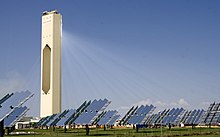User:Dalek sg/Solar power

太阳能发电是转化太阳光到电的结果。太阳光可以直接通过太阳能光伏,或者间接地用聚集太阳能动力(en:concentrating solar power,CSP)聚焦太阳的能量让水煮沸,然后再用来提供电力。最大的太阳能发电站,像 354 MW SEGS,是转换太阳能的工厂,但最新建立了兆瓦的光电池。完成于 2008 年,46 MW Moura光电池电源部署在葡萄牙和德国的 40 MW Waldpolenz 太阳能公园是的特征趋势接近大的光电池电源站。更大的提议,如 550MW 的 Topaz 太阳能发电站,和 600 MW 的 RanchoCielo 太阳能发电站。
太阳能动力是可预测的间歇性能量来源,意味着太阳能发电是不在任何时候都具备,我们可以对何时具备,何时不具备预测出很高的正确程度,一些技术,像太阳能同蓄热器的元素,像熔融盐类。Salts are an effective storage medium because they are low-cost, have a high specific heat capacity and can deliver heat at temperatures compatible with conventional power systems, have the potential to eliminate the intermittency of solar power, by storing spare solar power in the form of heat; and using this heat overnight or during periods that solar power is not available to produce electricity. This technology has the potential to make solar power "dispatchable", as the heat source can be used to generate electricity at will. Solar power installations are normally supplemented by storage or another energy source, for example with wind power and hydropower.
